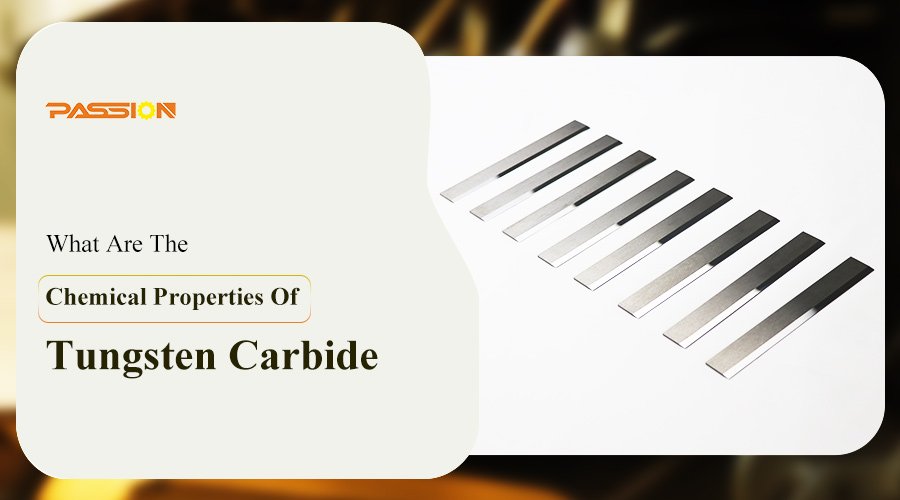Tungsten carbide (WC), a compound composed of equal parts tungsten and carbon, has become indispensable across various industries due to its exceptional strength, durability, and versatility. Known for its remarkable hardness and resistance to wear, tungsten carbide is a go-to material for manufacturing precision tools such as cutting blades, industrial slitting knives, and more. Its unique combination of chemical stability and physical toughness makes it one of the most reliable materials for high-performance applications.
With a melting point of approximately 2,830°C and a density of 15.6 g/cm³, tungsten carbide is both dense and incredibly hard. These properties, along with its resistance to corrosion and wear, make it ideal for use in demanding environments. Whether in cutting tools or industrial machinery, tungsten carbide ensures longevity and precision.
Beyond its physical attributes, tungsten carbide’s chemical resilience further solidifies its status as a top choice for industries requiring durable, high-precision tools.
Tungsten carbide (WC) is prized for its exceptional chemical and structural integrity, making it a cornerstone material in many industrial applications. Below are its key chemical properties:
Chemical Formula: Tungsten carbide is represented by the formula WC, consisting of one tungsten (W) atom and one carbon (C) atom. This precise one-to-one ratio provides a balance between hardness and toughness, which is critical for applications like cutting tools and wear-resistant components.
Molar Mass: The molar mass of tungsten carbide is 195.85 g/mol, reflecting the combined atomic masses of tungsten and carbon. This contributes to its overall density and weight, making it a robust material for heavy-duty applications.
Appearance: In its pure form, tungsten carbide has a gray-black, lustrous appearance, giving it a metallic sheen. This visual appeal makes it not only functional but also desirable for aesthetic applications, such as in jewelry or decorative coatings.
Density: With a density of 15.6 g/cm³, tungsten carbide is nearly twice as dense as steel and approaches the weight of lead. This high density contributes to its durability and wear resistance, making it ideal for tools that endure heavy use.
Melting Point: Tungsten carbide boasts an exceptionally high melting point, ranging between 2,785–2,830°C (5,045–5,126°F). This heat resistance ensures its stability in extreme temperature environments, such as those encountered in machining, cutting, and industrial processes.
Chemical Stability: Tungsten carbide is highly chemically stable, resistant to oxidation under normal conditions, and able to withstand exposure to most acids and alkalis. This resilience makes it a top choice for use in harsh industrial environments where chemical exposure is a concern.
These core properties make tungsten carbide a versatile and reliable material for a wide range of demanding applications.
How Does Tungsten Carbide React Chemically?
Despite its renowned stability, tungsten carbide can react with certain chemicals under specific conditions, leading to potentially hazardous outcomes. Below are some key chemical reactions involving tungsten carbide:
Oxidation: While tungsten carbide is resistant to oxidation at room temperature, it becomes vulnerable when exposed to elevated temperatures. Oxidation begins at around 500°C (932°F) and accelerates as temperatures rise. During this process, a layer of tungsten oxide forms on the surface, which, if left unchecked, can degrade the material’s performance over time, particularly in high-precision applications.
Reaction with Strong Oxidizing Agents: Tungsten carbide reacts violently with certain strong oxidizers, such as fluorine (F₂), chlorine trifluoride (ClF₃), and lead dioxide (PbO₂). These reactions can be highly exothermic, leading to combustion or rapid breakdown of the material. For example, in the presence of chlorine trifluoride, tungsten carbide may ignite spontaneously, posing significant safety risks in uncontrolled environments. Proper handling and storage are essential to avoid such dangerous reactions.
Nitric Acid-Hydrofluoric Acid Mixture: Though tungsten carbide is highly resistant to most chemicals, it is susceptible to attack by a mixture of nitric acid (HNO₃) and hydrofluoric acid (HF). This combination can break down the carbide structure, compromising its integrity and rendering it unstable. To preserve the longevity and performance of tungsten carbide tools, they should be protected from exposure to this corrosive mixture.
Understanding these reactions is crucial for ensuring the safe handling and optimal performance of tungsten carbide in industrial settings.
What Is The Composition Of Tungsten Carbide In Industrial Tools?
In industrial tools, the composition of tungsten carbide is carefully calibrated to strike the right balance between hardness, toughness, and wear resistance. The most common formulation used in tools typically includes:
Tungsten: Comprising about 90% by weight, tungsten is the backbone of the material. It delivers exceptional hardness and wear resistance, critical for applications requiring precision cutting or long-lasting durability.
Carbon: Making up roughly 10%, carbon bonds with tungsten to form tungsten carbide. This chemical combination enhances toughness and helps the material retain sharpness over extended use.
This composition ensures that tungsten carbide maintains its structural integrity under stress, making it the go-to material for a wide range of industrial applications, from cutting and drilling to grinding.
What Are The Physical And Chemical Properties Of Tungsten Carbide?
Tungsten carbide’s physical properties work hand-in-hand with its chemical composition, giving it a range of advantages in industrial applications. Here are some key physical properties that arise from its unique chemical structure:
Hardness: Tungsten carbide ranks near 9 on the Mohs scale, making it one of the hardest materials available. This extreme hardness enables it to cut through tough materials like metals and stone with remarkable ease.
Wear Resistance: Thanks to its hardness and chemical stability, tungsten carbide offers exceptional wear resistance. This is crucial in applications where the material faces constant abrasion, as it retains its structure and sharpness over prolonged use.
Corrosion Resistance: Tungsten carbide is highly resistant to most acids and alkalis, although it can be vulnerable to a mixture of nitric and hydrofluoric acids. Its overall corrosion resistance makes it ideal for harsh industrial environments where chemical exposure is a concern.
Thermal Conductivity: With excellent thermal conductivity, tungsten carbide efficiently dissipates heat. This property is particularly valuable in high-temperature applications, such as machining, where excess heat could otherwise damage the tool or the workpiece.
These physical attributes, combined with its chemical resilience, make tungsten carbide a top choice for demanding industrial tasks.
What Are The Uses Of Tungsten Carbide?
Tungsten carbide’s unique chemical and physical properties make it indispensable across a variety of industries:
Cutting Tools: Tungsten carbide is a go-to material for manufacturing cutting tools like saw blades, drill bits, and slitting knives. Its exceptional hardness allows it to cut through tough materials—metal, wood, plastic—with precision and long-lasting durability.
Mining and Drilling: In the mining sector, tungsten carbide is used for drilling and cutting through rock. Its wear resistance and ability to endure extreme conditions make it an ideal choice for heavy-duty applications in this industry.
Aerospace: Tungsten carbide plays a critical role in the aerospace industry, where it’s used in components that must endure high temperatures and friction, such as turbine blades and other essential engine parts.
Industrial Blades: Companies like PassionBlade rely on tungsten carbide to produce customizable industrial blades known for their superior performance and longevity. Thanks to its high hardness and corrosion resistance, tungsten carbide ensures that these blades stay sharp and effective, even after extended use.
Its versatility and resilience make tungsten carbide a key material in industries that demand both precision and durability.
What Are The Main Benefits Of Using Tungsten Carbide In Blades?
Tungsten carbide offers a range of benefits when used in the manufacturing of industrial blades, particularly in terms of performance and durability. Key advantages include:
Longevity: Tungsten carbide blades outlast those made from steel or other materials, significantly reducing the frequency of replacements and downtime.
Precision: Thanks to its chemical stability and exceptional hardness, tungsten carbide enables highly precise cuts. This makes it an ideal choice for precision blades used in industries like printing, packaging, and metalworking, where accuracy is critical.
Corrosion Resistance: Tungsten carbide’s resistance to most chemicals ensures that blades maintain their effectiveness, even in corrosive or harsh environments.
These benefits make tungsten carbide a superior material for industrial blades, delivering both high performance and cost efficiency over time.
In conclusion, tungsten carbide stands out as a remarkable material, offering a unique blend of chemical and physical properties that few other materials can match. Its resistance to heat, wear, and corrosion makes it the material of choice for a broad spectrum of industrial applications, from cutting tools to aerospace components. Companies like PassionBlade capitalize on tungsten carbide’s strengths to manufacture high-quality, durable industrial blades, ensuring their clients benefit from top-tier performance and longevity.



